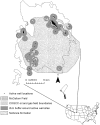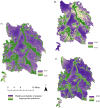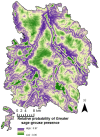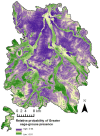Seasonal Habitat Use by Greater Sage-Grouse (Centrocercus urophasianus) on a Landscape with Low Density Oil and Gas Development
- PMID: 27788202
- PMCID: PMC5082953
- DOI: 10.1371/journal.pone.0165399
Seasonal Habitat Use by Greater Sage-Grouse (Centrocercus urophasianus) on a Landscape with Low Density Oil and Gas Development
Abstract
Fragmentation of the sagebrush (Artemisia spp.) ecosystem has led to concern about a variety of sagebrush obligates including the greater sage-grouse (Centrocercus urophasianus). Given the increase of energy development within greater sage-grouse habitats, mapping seasonal habitats in pre-development populations is critical. The North Park population in Colorado is one of the largest and most stable in the state and provides a unique case study for investigating resource selection at a relatively low level of energy development compared to other populations both within and outside the state. We used locations from 117 radio-marked female greater sage-grouse in North Park, Colorado to develop seasonal resource selection models. We then added energy development variables to the base models at both a landscape and local scale to determine if energy variables improved the fit of the seasonal models. The base models for breeding and winter resource selection predicted greater use in large expanses of sagebrush whereas the base summer model predicted greater use along the edge of riparian areas. Energy development variables did not improve the winter or the summer models at either scale of analysis, but distance to oil/gas roads slightly improved model fit at both scales in the breeding season, albeit in opposite ways. At the landscape scale, greater sage-grouse were closer to oil/gas roads whereas they were further from oil/gas roads at the local scale during the breeding season. Although we found limited effects from low level energy development in the breeding season, the scale of analysis can influence the interpretation of effects. The lack of strong effects from energy development may be indicative that energy development at current levels are not impacting greater sage-grouse in North Park. Our baseline seasonal resource selection maps can be used for conservation to help identify ways of minimizing the effects of energy development.
Conflict of interest statement
The authors have declared that no competing interests exist.
Figures




References
-
- Kirol CP, Beck JL, Huzurbazar SV, Holloran MJ, Miller SN. Identifying greater sage-grouse source and sink habitats for conservation planning in an energy development landscape. Ecol Appl. 2015; 25: 968–990. - PubMed
-
- Fedy BC, Doherty KE, Aldridge CL, O’Donnell M, Beck JL, Bedrosian B, et al. Habitat prioritization across large landscapes, multiple seasons, and novel areas: An example using greater sage-grouse in Wyoming. Wildlife Monogr. 2014; 190: 1–39.
-
- Schroeder MA, Aldridge CL, Apa AD, Bohne JR, Braun CE, Bunnell SD, et al. Distribution of sage-grouse in North America. Condor 2004; 106: 363–376.
-
- U. S. Fish and Wildlife Service. Endangered and threatened wildlife and plants; 12-month finding on a petition to list the greater sage-grouse (Centrocercus urophasianus) as an endangered or threatened; proposed rule: Federal Register, v. 80, pp. 59,857–59,942.
-
- Connelly JW, Rinkes ET, Braun CE. Characteristics of greater sage-grouse habitats: a landscape species at micro- and macro- scales In: Knick ST, Connelly JW, editors.Greater sage-grouse: ecology and conservation of a landscape species and its habitats. Studies in Avian Biology (vol. 38), University of California, Berkeley; 2011. pp. 69–83.
MeSH terms
Substances
LinkOut - more resources
Full Text Sources
Other Literature Sources
Miscellaneous

